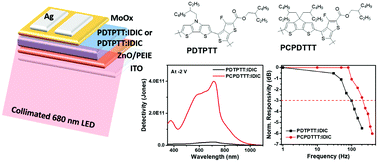Development of low bandgap polymers for red and near-infrared fullerene-free organic photodetectors†
Abstract
Two photoconductive conjugated polymers (PDTPTT and PCPDTTT) were synthesized to be utilized in red and near-infrared (NIR) organic photodetectors (OPDs). The low bandgap was achieved by stabilizing the quinoidal structure of the conjugated backbone, and both donor polymers showed strong red and NIR absorption in the range of 500–900 nm. To enhance the exciton separation and intensify the red and NIR absorption, p–n bulk heterojunction OPDs were fabricated by blending a PDTPTT (or PCPDTTT) and a low bandgap nonfullerene acceptor (IDIC). The PCPDTTT:IDIC devices showed excellent OPD performances with a detectivity (D*) of 1.14 × 1012 Jones and a −3 dB bandwidth (f−3dB) of 211.7 Hz at −1 V, whereas the PDTPTT:IDIC devices were not successful due to the high dark current density (JD) at negative bias. The interfacial energies of the PDTPTT:IDIC and PCPDTTT:IDIC blends were calculated by measuring the solvent contact angles and we found that the lower interfacial energy of the PCPDTTT:IDIC blends could make a well-mixed nanomorphology in the blend films, resulting in superior OPD properties. On the other hand, the shallow HOMO energy level (−4.66 eV) of PDTPTT could make substantial JD, which showed suboptimal OPD performances.

- This article is part of the themed collection: NJC Emerging Investigators


 Please wait while we load your content...
Please wait while we load your content...